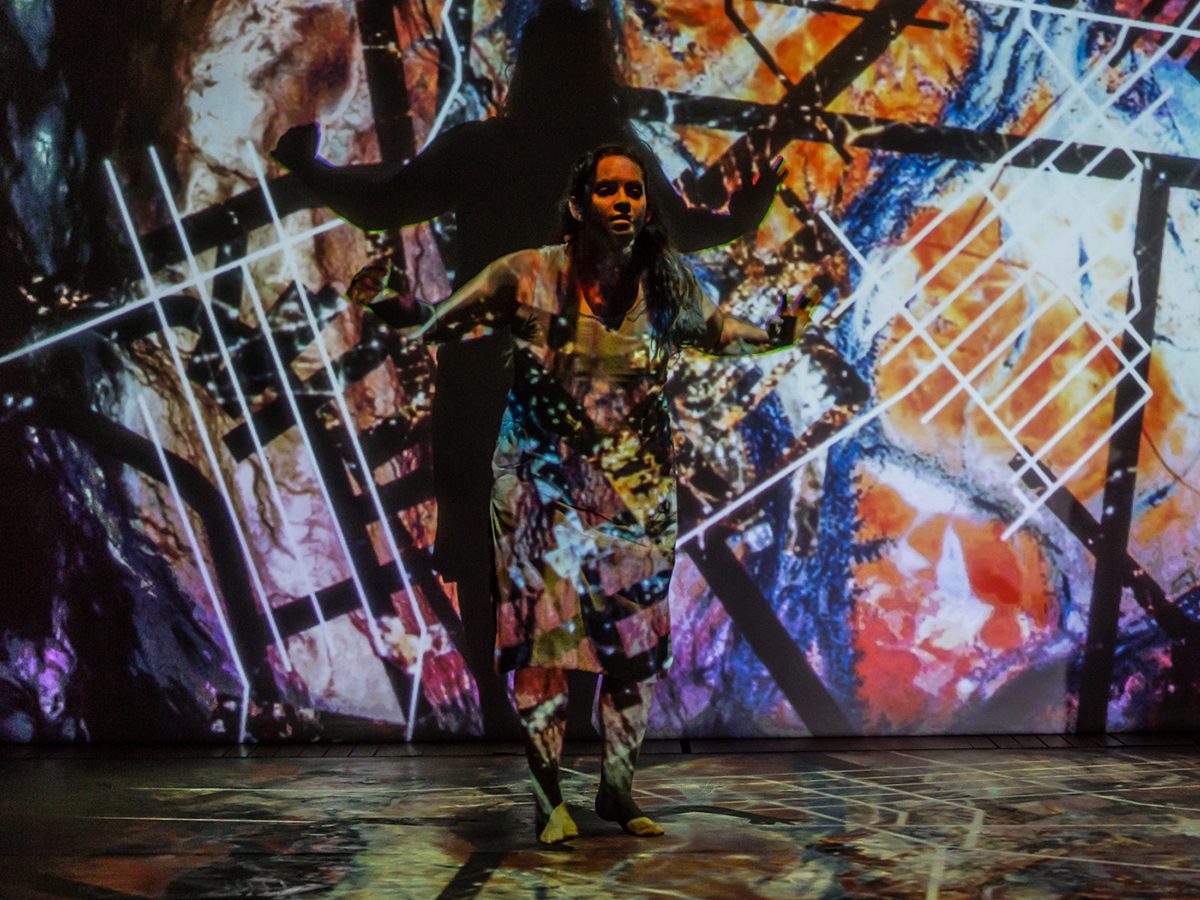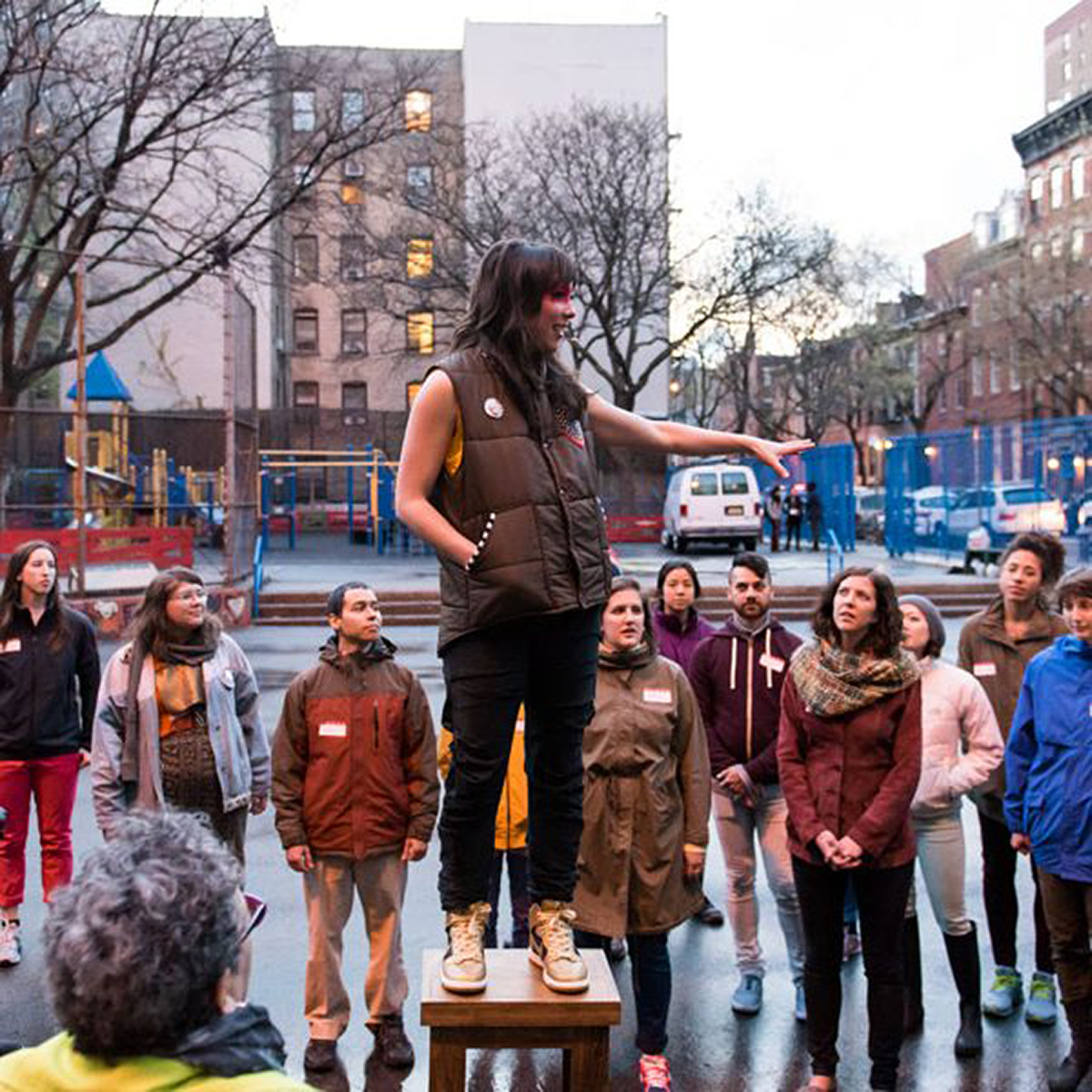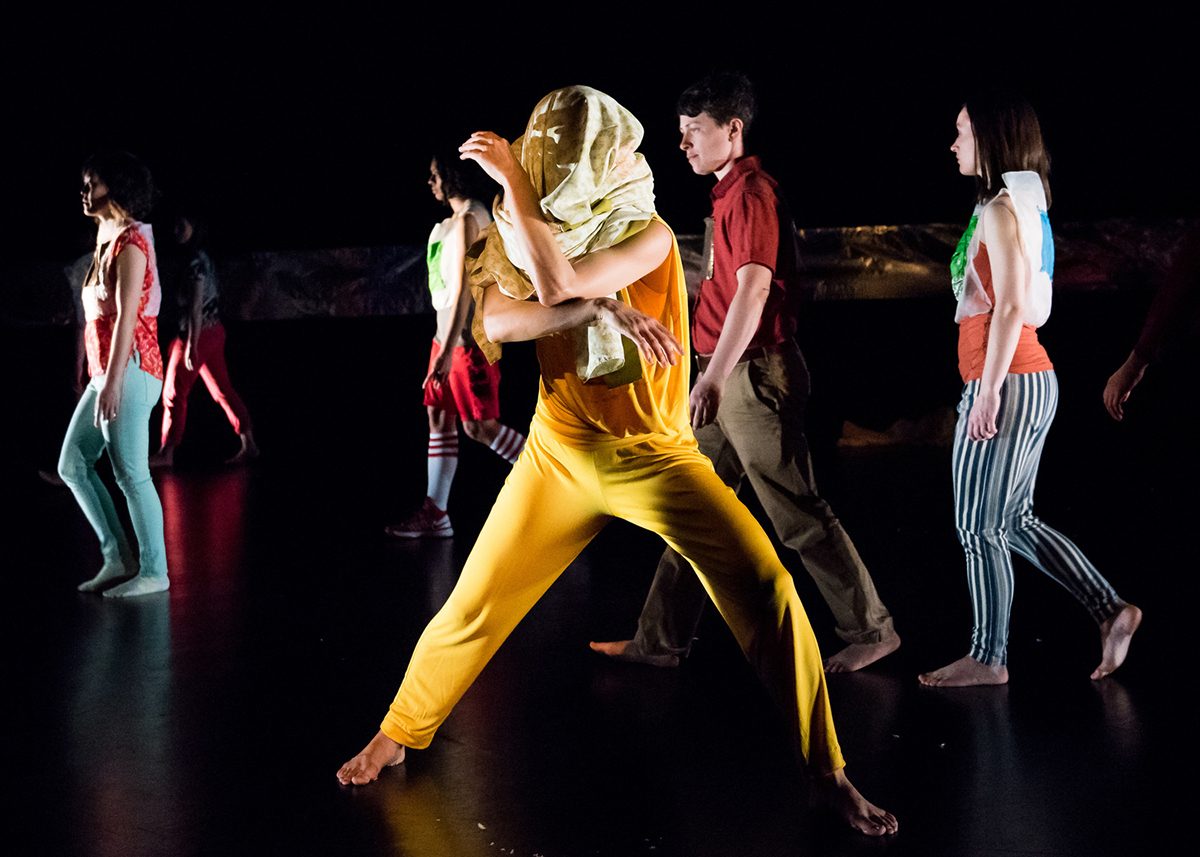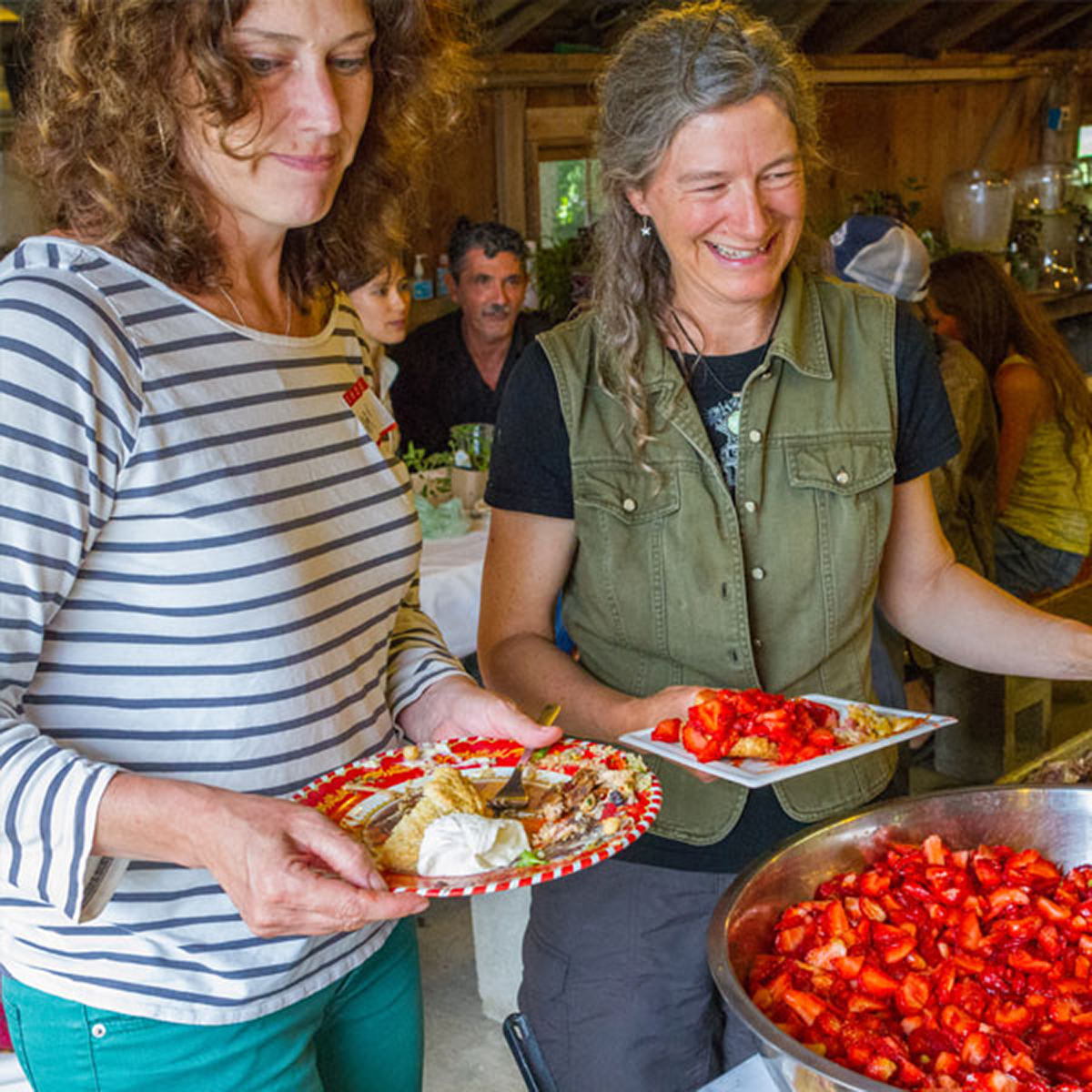“Tell us a yarn…” Henrietta Baird asks of Ngioka Bunda-Heath as they reel up lengths of duct-tape to reveal the cartographic symbol their movement has mapped across the floor. Over the course of the performance the two dancers have flooded the stage with powdered, coloured dyes that billow from their white cotton dresses. As they haul in the tape, they speak casually, coyly, about fishing trips and misunderstandings. The content of their dialogue is charmingly trivial, but as the act of conversing intersects with that of uncovering the negative space beneath the dust, a notion of greater significance is communicated. In Divercity, choreographer Mariaa Randall addresses the role of individuality as it exists within and through culture.
Though Bunda-Heath and Baird share heritage and identity as Indigenous Australians, each comes from a distinct cultural group and country. Baird has ties to the Kuku-Yalinji, while Bunda-Heath is a descendant of the Wakka Wakka, Biripi and Ngugi people. Consequently their dialogue in Divercity, as it plays out through movement, video projection and speech, involves difference and similarity, mapping points of divergence and transcendence as they exist in and between cultures and individuals.
This idea of mapping is represented literally late in the piece as increasingly distinguishable birds-eye-view representations of cities and intersecting roads are projected onto the dancers and the backdrop. As the dancers perform high-intensity phrases of abrupt isolation of limbs, the projections characterise them as part of a complex network of junctures and deviations: their bodies sites which multiple stories extend across and bisect. For all their symbolic resonance however, these projections flatten the movement, much of which takes place in the back third of the stage. The subsequent distancing between audience and dance seems unnecessarily contrary to the piece’s conversational tone and the encompassing seating arrangement that borders the stage on three sides.
This is in part a symptom of a wider problem: the movement lacks focus and clarity. This is apparent as the dancers kneel on the floor, repeating a series of words and phrases, some in English and others in Indigenous dialects. It is the first time the two have engaged each other verbally, and as they dismiss turns of phrase or imagined acquaintances with terms like “big noter,” the audience laugh in acknowledgement of a sardonic sensibility that is understood regardless of the specifics of language or culture. Yet the meaning behind the accompanying movement is less legible, as the dancers perform a series of indistinct sliding motions and grounded extensions that seem to function principally as a means of distributing the powdered dye across the floor. That the movement in an otherwise witty sequence operates primarily as a set-up undermines the piece’s incisive exploration of communication and translation, and gestures towards a sense of the unfinished in a manner that seems accidental rather than a fundamental aspect of the work’s thematic interrogation.
Divercity is more successful when it plays directly and intentionally to the informal and the organic. In a participatory preface, female-identifying attendees are asked to enter the space prior to male audience members, and are let in on a secret. They partake in a learning process that is to be kept to themselves until later when they are called upon to join the conversation. This initiation into the work fosters a quality that is uncommon to many contemporary dance works that keep audiences at a slight remove and privilege bodies before personalities. In eschewing refinement in favour of a sense of genuine interaction between artists and audience, this introduction represents what feels by performance’s end to be the clearest distillation of the dynamics of diversity and unity that Randall is seeking to explore.
As the work draws to a close with Bunda-Heath and Baird removing the lengths of duct-tape, the union of the work’s clumsy physicality and charming wit is particularly striking. There is no graceful or brief way to undertake the task, and consequently the dancers’ conversation meanders from the scripted to a seemingly authentic state of flippancy. When the dancers are able to communicate in this individualistic way, the work is offhandedly perceptive and disarming. Here it is apparent that while Mariaa Randall as an emerging director and choreographer may not yet have realised a movement vocabulary with which to coherently communicate her ideas, her understanding of when and how to allow the personalities of her dancers to carry a concept suggests a potential yet be fully articulated.
–
Yirramboi Festival, Divercity, choreographer Mariaa Randall, performers Henrietta Baird, Ngioka Bunda-Heath; Weelam Ngalut (Art House Meat Market), Melbourne, 11-13 May
Top image credit: Henrietta Baird, Ngioka Bunda-Heath, Divercity, Mariaa Randall, Yirramboi, photo Bryony Jackson
From Gatehouse Street, North Melbourne, we head into Royal Park, up the hill toward the large open space planted with native grasses. There, under a large eucalypt, we find a sign festooned with fairy lights: “Gather here.” The tree is lit from below with spotlights, and the whole park is the most spectacular night-time theatre. There is so much space, so much darkness and so many distant and attractive lights. And in the east, rising through the trees, a gibbous moon, lupine yellow.
The performance begins with a ritualistic procession involving some 20 or so would-be votaries chanting and circling the audience in the dark. Then Emily Johnson, a New York-based writer and choreographer of Alaskan Yup’ik descent, standing on a box under the tree, addresses the crowd. She tells us that once there was another tree behind this one, and she points into the darkness. It’s as if she means somewhere else, not simply over there but on the other side of something profound.
There are many such slips and wrinkles in this performance, gestures towards other realities, connections and openings between different epochs and cultures. What is it which gathers here, under the tree? People, yes, but also different times and places and traditions, fabrics drawn around a single dreaming point.
Why, for instance, is the work called SHORE? We are meeting on the high ground overlooking the city, a long way from the ocean. Is this the site of a future shore? As we look south, across the ancient Yarra delta, in the direction of Bass Strait, are we looking forward to a time of inundation?
Eventually, we are invited to walk to North Melbourne Town Hall; and it’s hard not to be moved by the invitation, what with the moon and the skyline and the tree so artfully illuminated. So, from Royal Park we follow the course of Williams Creek, an extinct watercourse that is not extinct, we are told, but only dormant, dreaming beneath the asphalt and concrete.
So much for the first, wonder-exciting section of SHORE in NARRM, presented by Arts House as part of the Yirramboi First Nations Arts Festival. Although it’s only a prelude to the main event, the guided walk from the park through the cobbled laneways does much to channel the mysteries of night and to convey a sense of congregation. The second section, however, inside the main hall at the North Melbourne Town Hall, is less compelling.
Again, we have a large cast of performers, including a choir led by Margot Bassett Silver and Indigenous-Australian singer-songwriter Maylene Slater-Burns. And again Johnson is at the centre, supported by dancers Ben Hurly and Jacqueline Aylward. Here the choreography is muscular and clean, with fierce lunges, swinging arms and long strides punctuated by juddering steps. This is authentic American modern dance, complete with bright retro-futurist costumes and stylised references to contemporary popular moves.
And yet there are many other parts to this performance besides dance that Johnson insists are also dance. At one point, for instance, we hear a collage of television commentary from the 1991 NBA play-offs between the Los Angeles Lakers and the Chicago Bulls. Dressed in high school sports kit, a cast member slowly moves centrestage, stands and stares out into the audience. After a few minutes, on a signal from Johnson, the audio cuts out and the cast member drifts back into the crowd. At another moment, Johnson performs a series of handstands off a long run-up. The choir sings, pot plants are shifted around the stage by smiling cast members and snow jackets are distributed.
What do these and other similarly cryptic moments and props signify? On what level are they connected? On what principle are they organised? Again there is the feeling that Johnson is gesturing beyond this time and place, back to her experiences growing up in Alaska or studying in Minnesota or whatever. But as choreography – in the more expansive sense — it feels messy, full of gaps and missed associations.
Nonetheless, there are some impressive images. I particularly like the climactic moment when Johnson announces the arrival of the whale in the room. When we were outside, under the tree, she told us that the whales were gathering out beyond the shore. It seems they have met us halfway, as if the stage were a kind of halfway lodge, a place for meetings and mergers.
Outside, in the night air, everything seems so huge, gleaming with significance; crammed back into a conventional theatre space, it all seems trivial and confused. For example, on the stage at the back of the room there are some eucalypt saplings in black plastic pots. Compared with the trees in the park, the gesture seems somehow inadequate — a diminution and a misunderstanding.
Still, it should be noted that SHORE in NARRM is a much larger performance installation event, and this performance is only one part of the experience. There’s also a day of volunteerism, a night of storytelling and, finally, a potluck feast. And Johnson insists that all of these, too, are part of the dance.
–
Yirramboi Festival: Emily Johnson / Catalyst, SHORE in NARRM, concept, choreography, writing Emily Johnson, director Ain Gordon, performers Jacqueline Aylward, Margot Bassett Silver, Ben Hurly, Emily Johnson, Maylene Slater-Burns, the Narrm SHORE Choir, lighting design Heidi Eckwall, costume design Angie Vo, scenic design Emily Johnson, Ain Gordon, James Everest; North Melbourne Town Hall, 12-13 May
Top image credit: SHORE, Emily Johnson, Yirramboi, photo courtesy the artists







